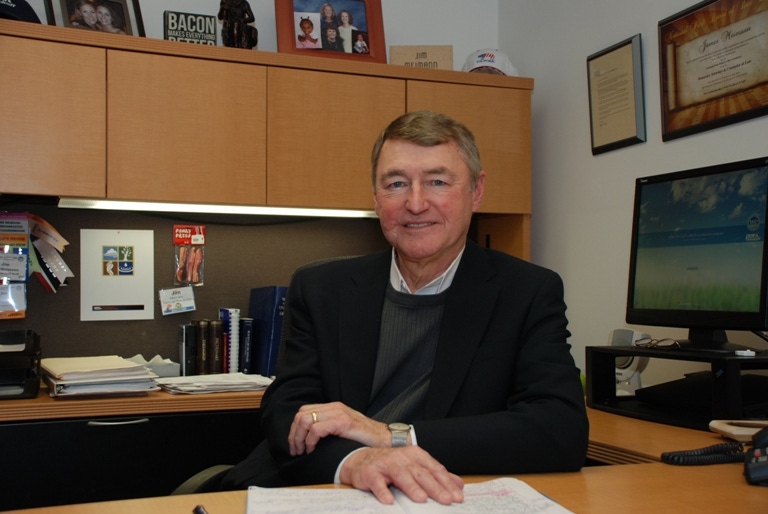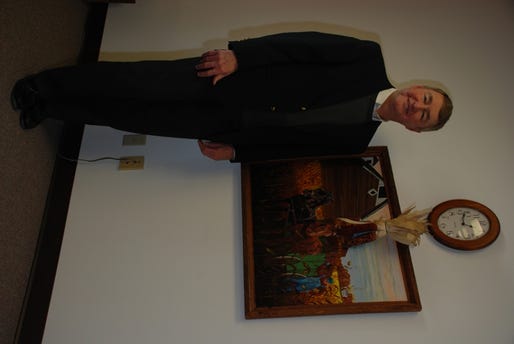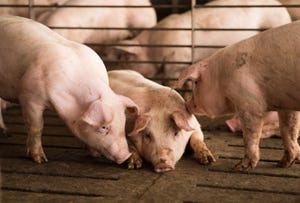2013 Master of the Pork Industry Jim Meimann
While some crave the limelight, Jim Meimann is content with letting the spotlight shine on others.
May 15, 2013

With deep-seated roots in the pork industry, Jim Meimann has taken a decidedly low profile in his responsibilities as senior vice president of governance and operations at the National Pork Board.
“I’m a behind-the-scenes kind of guy,” he explains. But don’t let his mild manner fool you; he is passionate about making sure pork producers get their money’s worth from their checkoff investments. He serves as the National Pork Board’s point person in their dealings with the USDA Agricultural Marketing Service (AMS), the government arm that oversees Pork Checkoff programs and spending.
Meimann’s willingness to serve was imbedded in him by his parents’ approach to rural life and their guiding principles “to be good farmers and good community people.”
Growing up near the unincorporated burg of Fernald, IA, population 100, Meimann describes the area as “a tight little farming community with beautiful farms and wonderful families.”
The farming tradition runs at least four generations deep on both sides of Meimann’s family. The family farm was diversified with corn, soybeans, rotating pastures, draft horses, Angus cattle, a few chickens and hogs.
Pig Projects
The first farrowing crates built for Meimann’s youth pig projects were made from native green oak lumber that would warp and twist, so hard it was nearly impossible to drive a nail into it. Later, he fashioned a farrowing crate by welding galvanized pipe and angle iron. His mother’s small flock of chickens was displaced by the crate, where his first prized Hampshire sow was set up to farrow.
“I checked on her at two o’clock in the morning and there she was, the proud little momma of 10 perfect little Hampshire pigs,” he remembers.
The following year, vocational agriculture teacher and early mentor Joe Harper convinced him to give his own favored Duroc breed a try. Two bred gilts were placed in separate deep-bedded pens, with guard rails and a cornered-off area for a heat lamp to warm the newborns. When he went to do morning chores, he found one gilt had 14 piglets, but all had succumbed to the frigid January temperatures. The other gilt had twins. “So, I had a couple of lessons about life and the pig business early on,” Meimann explains.
During his high school years, the Colo, IA, vocational agriculture and the FFA programs were intertwined. Harper singled Meimann out to represent the chapter in the freshman FFA creed speaking contest. “I really wasn’t comfortable with that sort of thing. I was scared to death,” he admits. But with the help of Harper and the high school English teacher, he polished his speech delivery, which qualified him to compete at the state level.
Like what you’re reading? Subscribe to the National Hog Farmer Weekly Wrap Up newsletter and get the latest news delivered right to your inbox every Friday!
The ability to memorize the special creed was fostered by his father, who encouraged all of his children to memorize and recite poetry and Lincoln’s Gettysburg Address, especially at family reunions or PTA meetings.
“Dad was heavily involved in the community, but was somewhat uncomfortable as a leader. On some important topics, his way of expressing himself was not through his own words, but through those of great poets and great writers, so we were frequently given the benefit of their thoughts and ideas. I realize now that that was a really important influence on me,” he notes.
College Years
“I had a love for farming but, like my parents, I was interested in other things. They instilled this sense of giving back, of doing something more, of being all you can be, and following your true calling. My father was both a farmer and a community man. My mother worked with the poor in the community as a public nurse and as a 4-H leader. She has a real generous heart,” Meimann explains.
Following high school graduation, Meimann, the eldest son, recognized the farm wasn’t big enough for him and his brother to return to the farm. “My brother really loved the farm, and he was good at it,” he says.
Meimann attended Iowa State University and majored in history and sociology. Confounded by the Vietnam War and great social change across the country, he took some agricultural courses, but also felt a calling outside of agriculture. One summer was spent working with the poor in Appalachia, another working with the disadvantaged in Wichita, KS. He joined the Army Reserves.
Jobs were hard to come by, so Meimann took a research and education position with the Civil Rights Commission. “That was a good thing. It allowed me to see a whole different side of society and the structures of government,” he says. “It also helped me realize that I was more comfortable in agriculture — something I knew and understood in my bones.”
State Government
Meimann’s next stop was with the Iowa Department of Agriculture and then-Secretary Bob Lounsberry, who was reorganizing and consolidating the department to form a new administrative division.
“Bob was a bigger-than-life farmer, a World War II bomber pilot, a real promoter of agriculture,” he explains. “He accepted every invitation to every event. It was his way of connecting with people, his way of campaigning. He relied on his staff to run the place.”
Secretary of Agriculture is an elected position in Iowa, but Meimann’s position as assistant secretary of agriculture was by appointment. He flourished there for 13 years, more or less behind the scenes. “I had to figure out how to manage people who didn’t want to be managed,” he explains. The wide range of groups and programs required a great deal of collaboration, which included Iowa’s first corn and soybean checkoff programs. He also helped organize the Iowa Century Farm program, introduced in the bicentennial year of 1976, as well as the Iowa Agriculture Youth Institute.
As Meimann’s knowledge and achievements mounted, Secretary Lounsberry approached him to serve as his deputy secretary of agriculture, which would position him as the heir apparent to run for the office.
“It was a great honor to be asked but, after much soul-searching, I declined. It wasn’t me,” he explains. “I knew I wouldn’t be comfortable doing it; I’d rather someone else be out front,” he confesses. “I’m a loyal person, willing to work hard and be there for you in whatever way I can, but I don’t want to be in the limelight. There are people who have enormous courage, with a willingness to put themselves on the line for a cause or idea, and even to get knocked down at times. I respect them very much. They need people to work with them and support them, too.”
Pork Checkoff’s Ground Floor
While at the Department of Agriculture, Meimann had many opportunities to work with the state’s commodity organizations. Specifically, he worked with Russ Sanders, a young, engaging man at the Iowa Development Commission, who moved to the Iowa Pork Producers Association and eventually to the National Pork Producers Council (NPPC).
In 1984-85, NPPC had begun efforts to initiate a mandatory checkoff. Congress passed the Pork Act in 1985, which provided for a national mandatory checkoff. It also initiated the need for NPPC to organize programs to comply with the Pork Act and Order and for Meimann to work with Mike Simpson at the new National Pork Board in coordinating operations. Sanders, the head of promotions at NPPC under CEO Orville Sweet, recruited Meimann for just such a position, as director of policy and administration.
“It was a good move to come to NPPC just when the checkoff was starting to work in lots of areas,” he says. “There was diversity of work to do and I thought it would be fun to be a part of it. I like pigs and pig people. I believed then and I believe now in the power of people coming together in the concept of an association, where they can accomplish much more together than any one person can on their own.”
Meimann describes then-CEO Orville Sweet as “one of the more visionary people” he has ever met. Sweet had commissioned a group in Kansas City, MO, to provide guidance on transitioning from a voluntary checkoff to a mandatory checkoff, including organizational structure and means of operation. “The ‘order’ interprets the ‘act’ in terms of regulation, establishing a board of directors with bylaws, policies and structures to implement the Pork Checkoff,” he explains.
Initially, the checkoff rate was 0.25% of the total value of a market hog, “but we didn’t know how much money would be coming in,” he continues. Accounting, auditing and administrative structures had to be put in place to develop and execute programming.
Fifteen board members were gleaned from the original list of 23 pork producers elected at the first Pork Act delegate session (now Pork Industry Forum). The list included several past presidents and leaders of NPPC. “They were very smart people who knew a lot about the association (NPPC), state and national politics, and were charged with crafting a new organization. Virgil Rosendale was perfect to lead it. He was a very considered, articulate man, but he was also a great leader in drawing out discussion,” Meimann explains.
The organizational structures also required very strict firewalls between NPPC and the National Pork Board, which was charged with managing and allocating checkoff funds. “There was a very high awareness that checkoff monies cannot be spent on influencing public policy,” he adds. The Pork Act focused on pork promotion, research and education.
“When times are good and everything is clicking along, producers just want to know that their money is being spent well and used to address their issues. Then, the 1998 hog market crash hit! There had always been excess packing capacity, but that wasn’t the case in 1998,” Meimann remembers.
Pork producers began asking more questions about the role of the checkoff and NPPC. The telephones at both pork organizations began to ring. For over 60 days, it was all hands on deck to field calls from concerned pork producers. “It was one of the most impactful times I can remember from a professional standpoint,” he notes.
“It was an aberration of high productivity, great crops and low packing capacity. We were seeing a way of life change as the industry shifted to more technology, larger size. Smaller producers were getting pushed out and they weren’t happy about it. The ‘mortgage lifter’ concept of pig production that we’d grown up with all of a sudden wasn’t working,” he says. “It was a really hard time around here.”
While NPPC staff urgently tried to explain programs to their constituents, delegate meetings were held, with lots of resolutions about market concentration, use of checkoff funds and checkoff rates. “These were all issues related to the stress in the industry and what the organizations should be doing,” he explains. “A task force was formed to put together a series of steps that maybe could help ameliorate the stress being felt in the industry.”“
A period of unrest ensued. Then USDA-Secretary Dan Glickman decided pork producers didn’t really want the checkoff to continue, called for a vote; a referendum was held and apparently failed. But, on Jan. 11, 2001, USDA directed the National Pork Board to shut down the Pork Checkoff. The order came on the heels of a national election, and soon Glickman was out and USDA Secretary Ann Veneman took over on Jan. 20. The NPPC filed a “stay” order to put a hold on the shutdown.
Upon review, Veneman decided “there was mischief in the process, the rules for a referendum hadn’t been followed and a referendum probably shouldn’t have been called for in the first place.” While the new secretary believed in the checkoff programs, she felt there were too many questions vexing pork producers and too much confusion about who was doing what. She ordered a complete separation of the two organizations (commonly known as “the separation agreement”), which meant NPPC could no longer be the primary general contractor for the checkoff. The agreement led to the formation of a “new” National Pork Board on July 1, 2001, which was to serve as its own general contractor, complete with the staff and services pork producers had come to rely on.
Some residual unrest continued as the constitutionality of the checkoff was challenged and wound its way through the Circuit Court of Appeals all the way to the U.S. Supreme Court, where in 2005, the justices ruled that the commodity checkoff programs were, in fact, constitutional and finally laid the matter to rest.
Meimann’s role throughout these tests of the Pork Checkoff was to help hold the staff and programs together. “This was a good place to work with fair salaries and good benefits and lots of professional opportunities, while helping producers,” he says.
Point Person

Key to the Pork Act and Order is the provision for government oversight by the Agricultural Marketing Service, a branch of the USDA. The Pork Act says there has to be oversight by a third party that guarantees to all producers that their checkoff money will be handled correctly and according to the law. “We fully support that concept and work hard to ensure that we meet all Pork Act requirements, although there is always a certain tension between doing what producers want and the necessary government oversight,” he explains.
“I’ve always considered myself to be a buffer between the government and producers. My approach has always been that we are a producer organization and this is producer money. My job is to understand and to work with USDA and to keep both sides in their proper roles,” he says.
Meimann is quick to point out that the USDA can also serve as an ally to the pork industry. “USDA stands between us and our adversaries. There are some people who go to USDA and demand things. If we provide USDA with good information that is accurate and meets the law, they can say, ‘They’re doing things right,’” he notes.
As Meimann nears retirement, he reflects: “I’ve liked this job. It’s something in which I have felt I could be of value. I believe in the checkoff program and I believe in the way the organizations [National Pork Board and NPPC] work together. I think the checkoff programs have provided resources and information that have benefited our industry over time. You enjoy something if you feel like you’re doing something important.”
Looking Forward
High on his priority list is addressing industry adversaries: “The immediate challenge is the increasing sophistication of our adversaries and their ability to get in front of influential people and the media — and be heard. They have the ability to characterize how our industry is run, and in a way that is pejorative to us. They drive what consumers see and hear. We have to somehow find a way to match up with that, to tell our story. Our success will rely on our ability to stay together — big and small, niche and company producers — all working toward a common goal,” he declares.
Finding the Magic
For over 28 years, Jim and Sue Meimann have provided foster care for about 75 newborn babies, plus 20-25 others taken in for respite care. “Sue loves babies. We love babies,” he corrects.
Many have been placed directly with the Meimanns from the hospital and often with drug-affected issues or other challenges. Most are kept from a few days up to a few months; occasionally, up to two years.
“We’ve had a lot of great babies. One of our little boys was with us for about two years and was adopted by a family up the street. He’s now 16 years old. We’re his godparents,” he says proudly.
“Sue does the late-night shift and I do the morning, so I get them up. Every day you get to see the world for the first time through their eyes. They may squint in the sunlight or follow the reflecting light off a particle of dust. There’s something magical and revitalizing about a baby,” he reassures.
— Dale Miller, Editor
You might also like:
2013 Master of the Pork Industry Bradley Wolter
2013 Master of the Pork Industry Malcolm DeKryger
2013 Master of the Pork Industry Bob Thaler
You May Also Like



